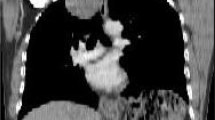Abstract
Pathological laughter is an uncommon manifestation of neurosurgical diseases. Very few cases of trigeminal schwannoma have been reported in the literature presenting with pathological laughter as a predominant symptom. We are reporting on a case of multi-compartmental trigeminal schwannoma presenting as pathological laughter and discuss a review of the literature. A 23-year-old lady presented with pathological laughter, along with symptoms pertaining to other cranial nerves and cerebellar dysfunction. Magnetic resonance imaging (MRI) of the brain was suggestive of a dumbbell-shaped mass in the middle and posterior cranial fossa on the left side, causing significant compression of the pons. She was investigated and operated for multi-compartmental trigeminal schwannoma. Following surgery, abnormal laughter disappeared immediately and no recurrence of symptoms was -present for a follow-up of 16 months. This case supports the role of the brainstem, especially the pons, in the control of laughter and, perhaps, of the medial temporal lobe too.



Similar content being viewed by others
References
Arroyo S, Lesser RP, Gordon B, Uematsu S, Hart J, Schwerdt P, Andreasson K, Fisher RS (1993) Mirth, laughter and gelastic seizures. Brain 116(Pt 4):757–780
Bhatjiwale MG, Nadkarni TD, Desai KI, Goel A (2000) Pathological laughter as a presenting symptom of massive trigeminal neuromas: report of four cases. Neurosurgery 47(2):469–472
Bouvier A, Chevalier JF, Brion S (1981) Pathological laughing and posterior fossa tumours (author’s transl) (in French). Encephale 7(1):83–94
Feinstein A, Connor P, Gray T, Feinstein K (1999) Pathological laughter and crying in multiple sclerosis: a preliminary report suggesting a role for the prefrontal cortex. Mult Scler 5(2):69–73
Gros C, Vlahovitch B (1960) Pathological laugh symptomatic of comprression of the brain stem by neurinoma of the trigeminal nerve (in French) Neurochirurgie 6:91–94
Garg RK, Misra S, Verma R (2000) Pathological laughter as heralding manifestation of left middle cerebral artery territory infarct: case report and review of literature. Neurol India 48(4):388–390
Lal AP, Chandy MJ (1992) Pathological laughter and brain stem glioma. J Neurol Neurosurg Psychiatry 55(7):628–709
Muzumdar D, Agrahar P, Desai K, Goel A (2001) Pathological laughter as a presenting symptom of petroclival meningioma. Neurol Med Chir (Tokyo) 41(10):505–507
Muzumdar DP, Goel A (2003) Pathological laughter as a presenting symptom of acoustic schwannoma: report of two cases J Clin Neurosci 10(3):384–386
Mendhekar DN (2004) Pathological laughter as an obsessive-compulsive phenomenon. Psychopathology 37(2):81–83
Machado AG, Aguiar PH, Marino R Jr (2002) Pathological laughter in a patient with trigeminal neurinoma. Arq Neuropsiquiatr 60(4):1000–1002
Nadkarni TD, Goel A (1999) Trochlear nerve neurinoma presenting as pathological laughter. Br J Neurosurg 13(2):212–213
Parvizi J, Anderson SW, Martin CO, Damasio H, Damasio AR (2001) Pathological laughter and crying: a link to the cerebellum. Brain 124(Pt 9):1708–1719
Poeck K (1985) Pathological laughter and crying. In: Frederiks J (ed) Handbook of clinical neurology, vol. 1. Clinical neuropsychology. Elsevier, Amsterdam, The Netherlands, pp 219–225
Rodriguez Campello A, Pascual Calvet J, Pou Serradell A (2003) Crazy laughter: first manifestation of a pontine tumour (in Spanish). Neurologia 18(4):225–228
Matsuoka S, Yokota A, Yasukouchi H, Harada A, Kadoya C, Wada S, Ishikawa T, Okuda S (1993) Clival chordoma associated with pathological laughter. Case report. J Neurosurg 79(3):428–433
Tsutsumi S, Hatashita S, Kadota Y, Abe K, Ueno H (2000) Tentorial meningioma associated with pathological laughter—case report. Neurol Med Chir (Tokyo) 40(5):272–274
Virani MJ, Jain S (2001) Trigeminal schwannoma associated with pathological laughter and crying. Neurol India 49(2):162–165
Wild B, Rodden FA, Grodd W, Ruch W (2003) Neural correlates of laughter and humour. Brain 126(Pt 10):2121–2138
Wilson SAK (1924) Some problems in neurology. 2. Pathological laughing and crying. J Neurol Psychopathol 16:299–333
Author information
Authors and Affiliations
Corresponding author
Additional information
Comments
Dattatraya Muzumdar, Mumbai, India
Although pathological laughter (PL) is well documented in the literature, it is still poorly understood. Jagetia et al. have reported a case of a trigeminal schwannoma presenting with PL, which disappeared immediately following surgery. This suggests that there is a definite role of severe compression of the pons and the medial temporal lobe. They have discussed the pathogenesis of PL in detail and also emphasized the recently described role of the cerebellum in the modulation of laughter and crying. Although laughing, together with crying and yawning, is a recognized pontomedullary reflex activity, the effects of a severely compressed temporal lobe and the activation of other structures involved in the important crossway of emotional mechanisms cannot be undermined. The anatomic localization of lesions that produce PL invariably involves motor pathways, and is located between the thalamus and the medulla. Various other pathologies, including meningiomas, chordomas, acoustic neuroma, and trochlear neuroma, in that region are known to present with PL. Complete excision of tumors in that region has resulted in immediate and permanent cessation of PL, thus, emphasizing the role of optimal surgery. The most common medical conditions leading to PL are: amyotropic lateral sclerosis, lacunar infarctions, diffuse hypoxic/hypotensive encephalopathies, and multiple sclerosis. However, the resolution of PL in these conditions is not as dramatic and complete as observed in tumor cases.
Rights and permissions
About this article
Cite this article
Jagetia, A., Pratap Kumar, N., Singh, D. et al. Pathological laughter in trigeminal schwannoma: case report and review of the literature. Neurosurg Rev 29, 348–352 (2006). https://doi.org/10.1007/s10143-006-0038-4
Received:
Revised:
Accepted:
Published:
Issue Date:
DOI: https://doi.org/10.1007/s10143-006-0038-4




